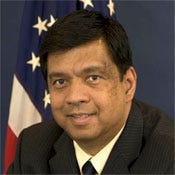5 Habits Of Highly Effective Government IT Leaders5 Habits Of Highly Effective Government IT Leaders
Former Department of Transportation CIO Nitin Pradhan offers lessons for up-and-coming and incoming government IT execs.

I have been fortunate to serve in a wide range of technology leadership positions with local, state and federal governments. My last job was CIO of the U.S. Department of Transportation, where I had oversight of its entire IT portfolio, including the Federal Aviation Administration (FAA). With an annual budget of more than $3 billion, DOT's was the sixth-largest IT budget in the federal government.
During this tenure of more than 15 years in the public sector, I was also fortunate to work and learn from some of the best (and worst) technology executives in the government, all of whom taught me some valuable lessons that may be as useful for up-and-coming government CIOs as they are for IT executives considering a jump into the public sector.
Here are my observations and recommendations on the five habits of highly effective government technology executives.
1. Follow The Legislative/Regulatory Environment
Effective government technology executives are fully tuned in to the happenings in their local boards, state assemblies or Congress. This is where new legislation is being drafted, which will result in specific regulations that will have a large impact on the IT systems either by way of modification or creation of new systems. If technology executives stay involved from the beginning, they have the potential to shape these legislations and regulations to be "technology friendly" and deliver technology systems and results speedily.
2. Focus Relentlessly On Mission Systems
Government IT is made up of mission IT systems (e.g., traffic control system), mission support IT systems (e.g., procurement system), and infrastructure or commodity IT (e.g., email system). Effective government technology executives have laser-like focus on building sophisticated mission systems or upgrading the existing ones to maximize the value to the citizens, businesses and other government agencies. Less effective government IT executives get bogged down and focus on infrastructure or commodity IT.
3. Position IT As A Valued Business Partner
The major goal of a government IT executive should be to position the IT department as a valued business partner to the mission offices or bureaus to drive increased public value. Public value is the delivery of high-quality, results-based services that drive business and citizen satisfaction and build trust in public enterprises. Unfortunately, many technology executives wrongly position their departments as "technical service providers" losing out on core value proposition.
4. Enlist Technical Talent With Mission Knowledge
Plain vanilla IT expertise works well for infrastructure or commodity IT, but it is insufficient to deliver results on mission systems. Today's mission IT projects in government are complex and require mission knowledge, advanced skill sets and engineering facilities that tend to keep them beyond the reach of traditional IT contractors. But alternatives are emerging. Unique services such as one I'm now involved in, the Technology Acceleration Infrastructure Program, can provide access to such high-end research, design, development, prototyping, testing, engineering, operations, troubleshooting and mission expertise without the need to maintain full-time staff or contractors.
5. Integrate Innovative, Cutting-Edge Products
Successful government IT executives know that solutions need to be delivered within the term of the elected officials and on (or under) budget. Large projects therefore need to be split up into manageable chunks and delivered using products and services rather than in-house development wherever possible to reduce cost, and improve speed of execution. However, finding such products is not easy for government IT executives. That's one reason I've chosen to lead another initiative, called GOVonomy. Its aim is to connect public sector organizations with relevant and innovative technology products from startups and growth companies and help arrange strategic discussions and demonstrations for increased understanding and education of the government IT professionals. (Like GOVonomy on Facebook to stay connected with this innovative program.)
The lessons I learned in the public sector have also convinced me of the importance of assimilating advances from the private sector quickly into public sector operations. That's one reason I started an organization called Public Private Innovations, with a goal to drive increased public value through private growth. We research government problems that can be solved using technology and then help connect government with private sector technology companies who have products or services to solve these problems. If you have knowledge of such government problems that need solving or have unique technology solutions to solve the government problems, let's talk
About the Author
You May Also Like






